C++之面向对象(中)
文章目录
- 前言
- 一、类的六个默认成员函数
- 二、构造函数
- 1.构造函数的引入(概念)
- 2.构造函数的特性
- 三、析构函数
- 1.析构函数的概念
- 2.析构函数的特性
- 四、拷贝构造函数
- 1.拷贝构造函数的概念
- 2.拷贝构造函数的特性
- 五、赋值运算符重载
- 1.运算符重载
- 2.赋值运算符重载
- 1.赋值运算符重载格式
- 2.赋值运算符只能重载成类的成员函数不能重载成全局函数
- 3.用户没有显式实现时,编译器会生成一个默认赋值运算符重载,以值的方式逐字节拷贝。
- 4. 前置++和后置++重载
- 六、取地址重载
- 1.日期类的实现
- 2.const成员
- 3.取地址及`const`取地址操作符重载
- 七、练习题
- 总结
前言
本文继续介绍C++中与面向对象相关的内容,主要介绍类的六个默认成员函数。
一、类的六个默认成员函数
如果一个类中什么成员都没有,简称为空类。
空类中真的什么都没有吗?
并不是,任何类在什么都不写时,编译器会自动生成以下6个默认成员函数。(默认成员函数:用户没有显式实现,编译器会生成的成员函数称为默认成员函数)
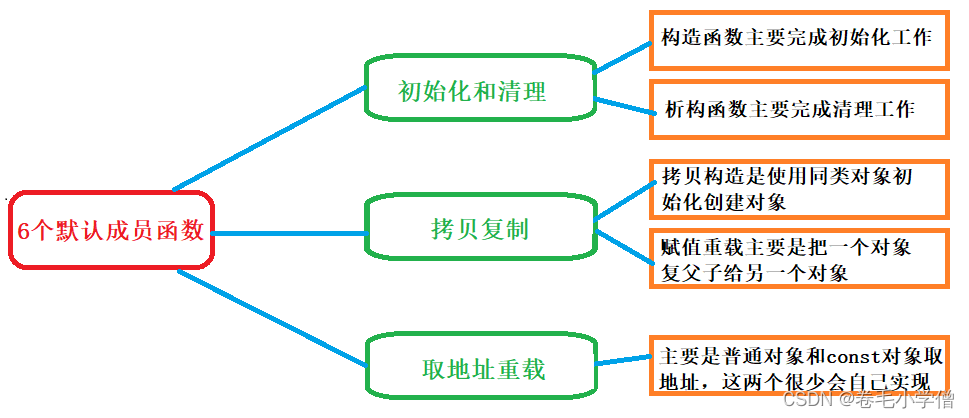
二、构造函数
1.构造函数的引入(概念)
对于Date类,可以通过 Init 公有方法给对象设置日期,但如果每次创建对象时都调用该方法设置信息,未免有点麻烦,那能否在对象创建时,就将信息设置进去呢?
构造函数就能实现这一功能。
构造函数是一个特殊的成员函数,名字与类名相同,创建类类型对象时由编译器自动调用,以保证每个数据成员都有一个合适的初始值,并且在对象整个生命周期内只调用一次。
2.构造函数的特性
构造函数是特殊的成员函数,需要注意的是,构造函数虽然名称叫构造,但是构造函数的主要任务并不是开空间创建对象,而是初始化对象。
特征如下:
- 函数名与类名相同。
- 无返回值(void也不能有)。
- 对象实例化时,由编译器自动调用对应的构造函数。
- 构造函数可以重载。
举例(定义一个日期类):
class Date
{
public:// 1.无参构造函数Date(){}// 2.带参构造函数Date(int year, int month, int day){_year = year;_month = month;_day = day;}
private:int _year;int _month;int _day;
};
void TestDate()
{Date d1; // 调用无参构造函数Date d2(2015, 1, 1); // 调用带参的构造函数// 注意:如果通过无参构造函数创建对象时,对象后面不用跟括号,否则就成了函数声明(会被编译器误会)// 以下代码的函数:声明了d3函数,该函数无参,返回一个日期类型的对象Date d3();
}
- 如果类中没有显式定义构造函数,则C++编译器会自动生成一个无参的默认构造函数,一旦用户显式定义编译器将不再生成。
class Date
{
public:
//用户显式定义构造函数Date(int year, int month, int day){_year = year;_month = month;_day = day;}void Print(){cout << _year << "-" << _month << "-" << _day << endl;}
private:int _year;int _month;int _day;
};
int main()
{Date d1;d1.Print();return 0;
}
运行结果:
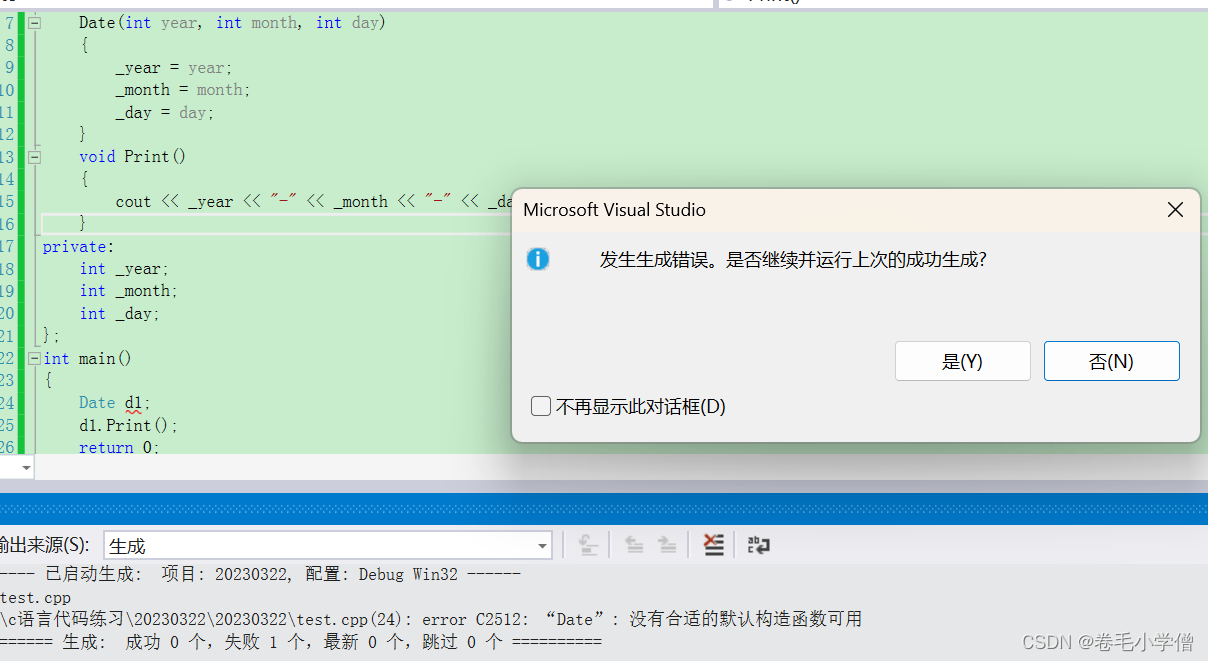
运行报错:error C2512: “Date”: 没有合适的默认构造函数可用。
如果将用户自定义的构造函数注释掉,即不显示定义构造函数,将会使用系统默认生成的构造函数。运行结果:
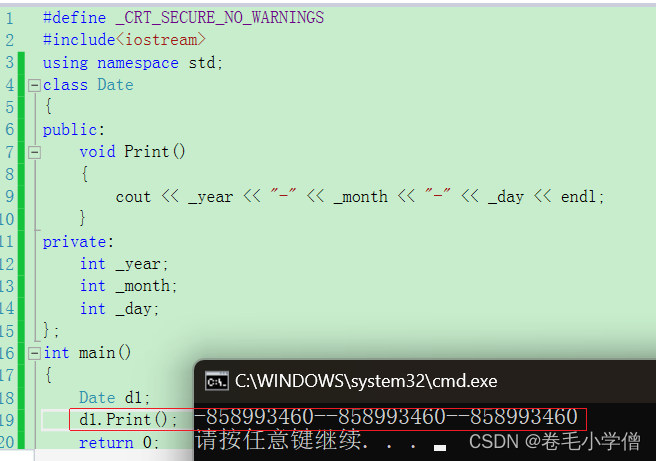
运行正常:将Date类中构造函数屏蔽后,代码可以通过编译,因为编译器生成了一个无参的默认构造函数;
- 编译器生成的默认成员函数,看起来没什么用。创建新Date对象调用了编译器生成的默认构造函数,但是新Date对象的
_year/_month/_day,依旧是随机值。也就说在这里编译器生成的默认构造函数并没有什么用?
解答:C++把类型分成内置类型(基本类型)和自定义类型。内置类型就是语言提供的数据类型,如:int/char...,自定义类型就是我们使用class/struct/union等自己定义的类型。
编译器生成默认的构造函数对这两种数据类型有不同的处理:
对内置类型成员不进行处理(即,仍为随机值);
对自定义类型成员会调用它的构造函数。
class Time
{
public:Time(){cout << "Time()" << endl;_hour = 0;_minute = 0;_second = 0;}
private:int _hour;int _minute;int _second;
};
class Date
{
private:// 基本类型(内置类型)int _year;int _month;int _day;// 自定义类型Time _t;
};
int main()
{Date d;return 0;
}
运行结果:
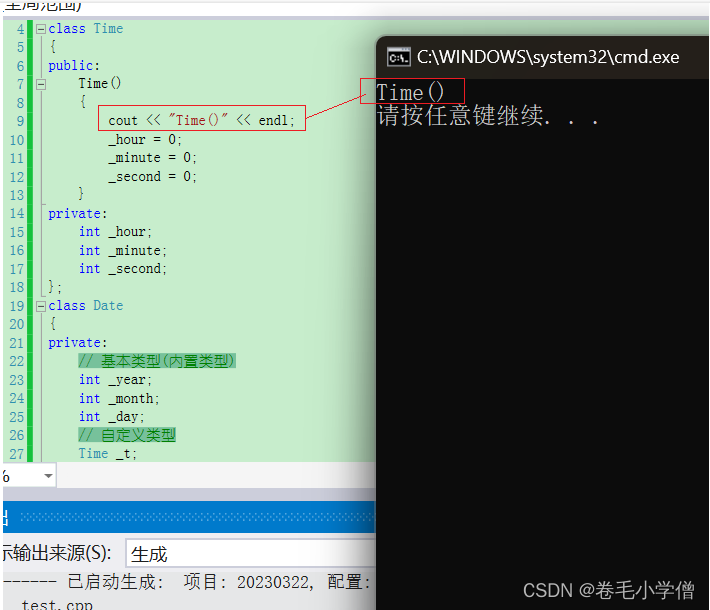
注意:C++11 中针对内置类型成员不初始化的缺陷,又打了补丁,即:内置类型成员变量在类中声明时可以给默认值。
class Time
{
public:Time(){cout << "Time()" << endl;_hour = 0;_minute = 0;_second = 0;}
private:int _hour;int _minute;int _second;
};
class Date
{
private:// 基本类型(内置类型)int _year = 1970;int _month = 1;int _day = 1;// 自定义类型Time _t;
};
int main()
{Date d;return 0;
}
- 默认构造函数只能有一个。
注意:无参构造函数、全缺省构造函数、我们没写编译器默认生成的构造函数,都可以认为是默认构造函数。
class Date
{
public:Date(){_year = 1900;_month = 1;_day = 1;}Date(int year = 1900, int month = 1, int day = 1){_year = year;_month = month;_day = day;}
private:int _year;int _month;int _day;
};
// 以下测试函数能通过编译吗?
void Test()
{Date d1;
}
运行结果:
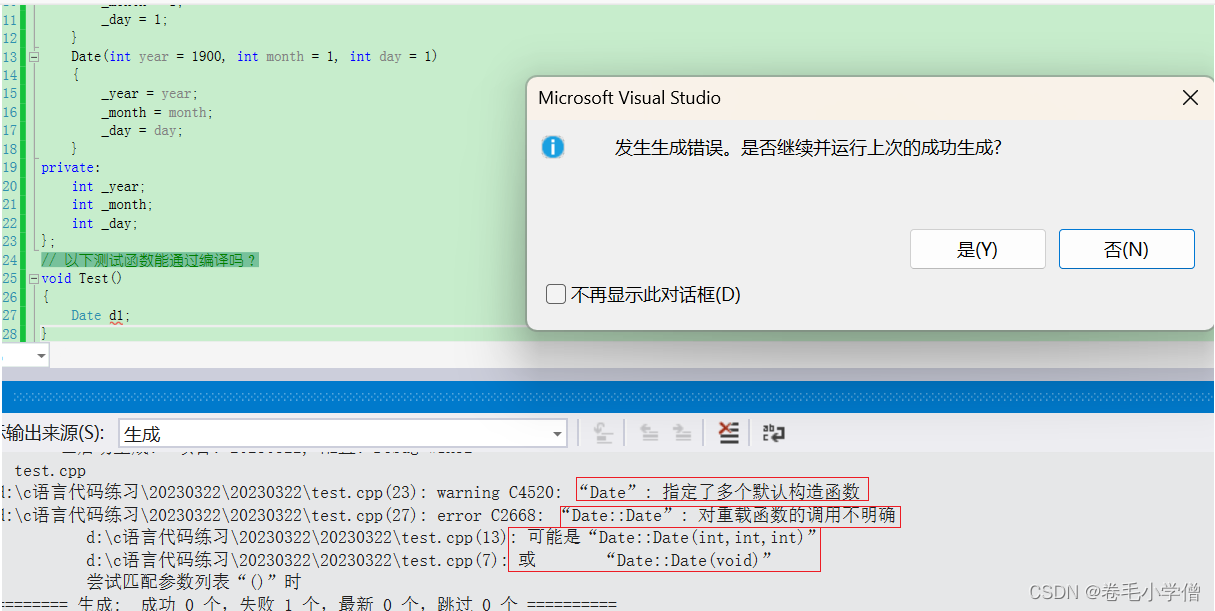
三、析构函数
1.析构函数的概念
通过前面构造函数的学习,我们知道一个对象创建时的初始化工作如何完成,那一个对象销毁过程中资源是如何释放的呢?
这就引入了析构函数,与构造函数功能相反,析构函数不是完成对对象本身的销毁,局部对象销毁工作是由编译器完成的,而对象在销毁时会自动调用析构函数,完成对象资源的清理工作。
2.析构函数的特性
- 析构函数名是在类名前加上字符
~。 - 无参数无返回值类型。(
void也不可以) - 一个类只能有一个析构函数。若未显式定义,系统会自动生成默认的析构函数。
注意:析构函数不能重载。 - 对象生命周期结束时,
C++编译系统自动调用析构函数
举例(定义一个栈类):
typedef int DataType;
class Stack
{
public:Stack(size_t capacity = 3)//构造函数{_array = (DataType*)malloc(sizeof(DataType)* capacity);if (NULL == _array){perror("malloc申请空间失败!!!");return;}_capacity = capacity;_size = 0;}void Push(DataType data){// 如果容量不够,则扩容CheckCapacity();_array[_size] = data;_size++;}// 其他方法...~Stack()//析构函数{cout << "~Stack()" << endl;if (_array){free(_array);_array = NULL;_capacity = 0;_size = 0;}}
private:DataType* _array;int _capacity;int _size;
};
void TestStack()
{Stack s;s.Push(1);s.Push(2);
}
int main()
{TestStack();
}
运行结果:
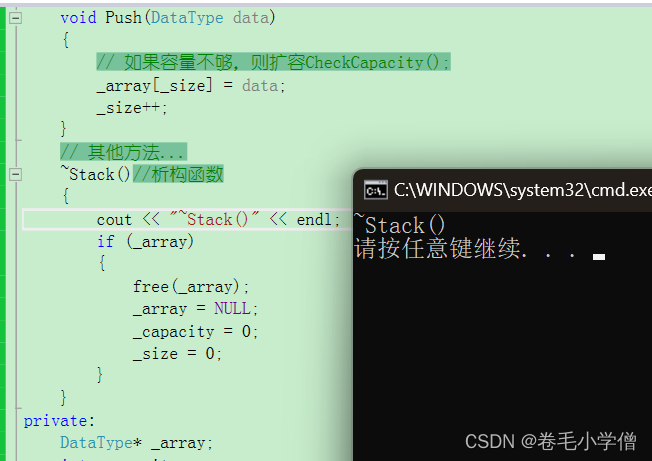
- 关于编译器自动生成的析构函数,是否会完成一些事情呢?
编译器生成的默认析构函数:内置类型成员不需要资源清理,自定类型成员会调用它的析构函数。
typedef int DataType;
class Time
{
public:~Time()//析构函数{cout << "~Time()" << endl;}
private:int _hour;int _minute;int _second;
};
class Date
{
private:// 基本类型(内置类型)int _year = 1970;int _month = 1;int _day = 1;// 自定义类型Time _t;
};
int main()
{Date d;return 0;
}
运行结果:

问:在main方法中根本没有直接创建Time类的对象,为什么最后会调用Time类的析构函数?
答:因为main方法中创建了Date对象d,而d中包含4个成员变量,其中_year, _month,_day三个是内置类型成员,销毁时不需要资源清理,最后系统直接将其内存回收即可;
_t是Time类对象,所以在d销毁时,要将其内部包含的Time类的_t对象销毁,所以要调用Time类的析构函数。
但是:main函数中不能直接调用Time类的析构函数,实际要释放的是Date类对象,所以编译器会调用Date类的析构函数,而Date没有显式提供,则编译器会给Date类生成一个默认的析构函数,目的是在其内部调用Time类的析构函数,即当Date对象销毁时,要保证其内部每个自定义对象都可以正确销毁main函数中并没有直接调用Time类析构函数,而是显式调用编译器为Date类生成的默认析构函数。
注意:创建哪个类的对象则调用该类的析构函数,销毁那个类的对象则调用该类的析构函数
6. 如果类中没有申请资源时,析构函数可以不写,直接使用编译器生成的默认析构函数,比如Date类;有资源申请时,一定要写,否则会造成资源泄漏,比如Stack类
四、拷贝构造函数
1.拷贝构造函数的概念
学习了构造函数可以对新对象进行赋初值后,我们可能会有一个问题:创建对象时,可否创建一个与已存在对象一某一样的新对象呢?如果可以,它又是怎么创建的?还是用构造函数进行初始化吗?
这就引出了拷贝构造函数,它只有单个形参,该形参是对本类类型对象(即,要拷贝的对象)的引用(一般常用const修饰),用已存在的类类型对象创建新对象时由编译器自动调用。
2.拷贝构造函数的特性
- 拷贝构造函数是构造函数的一个重载形式。
- 拷贝构造函数的参数只有一个且必须是类类型对象的引用,如果使用传值传参的方式编译器会直接报错(会引发无穷递归调用)。
举个例子:
class Date
{
public:Date(int year = 1900, int month = 1, int day = 1){_year = year;_month = month;_day = day;}// Date(const Date& d) // 正确写法Date(const Date d) // 错误写法:编译报错,会引发无穷递归{_year = d._year;_month = d._month;_day = d._day;}
private:int _year;int _month;int _day;
};
int main()
{Date d1;Date d2(d1);return 0;
}
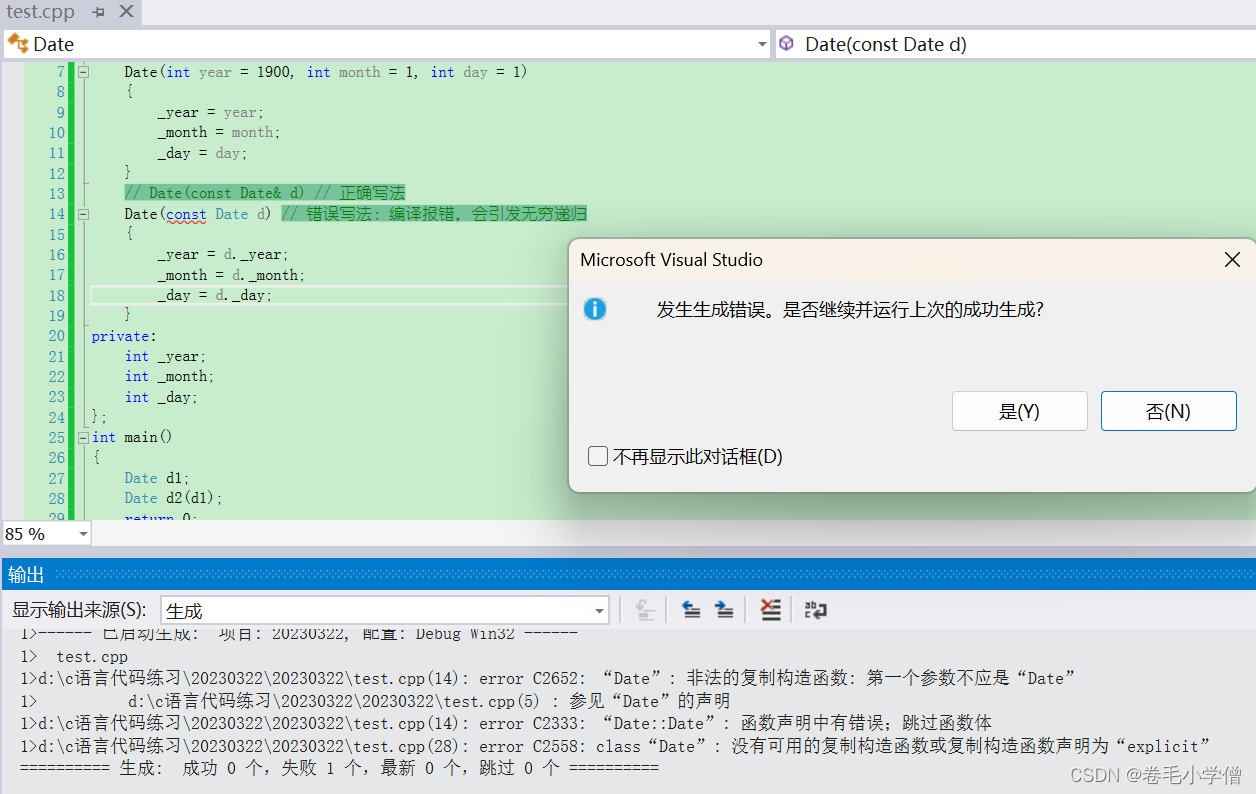
无穷递归调用图解:
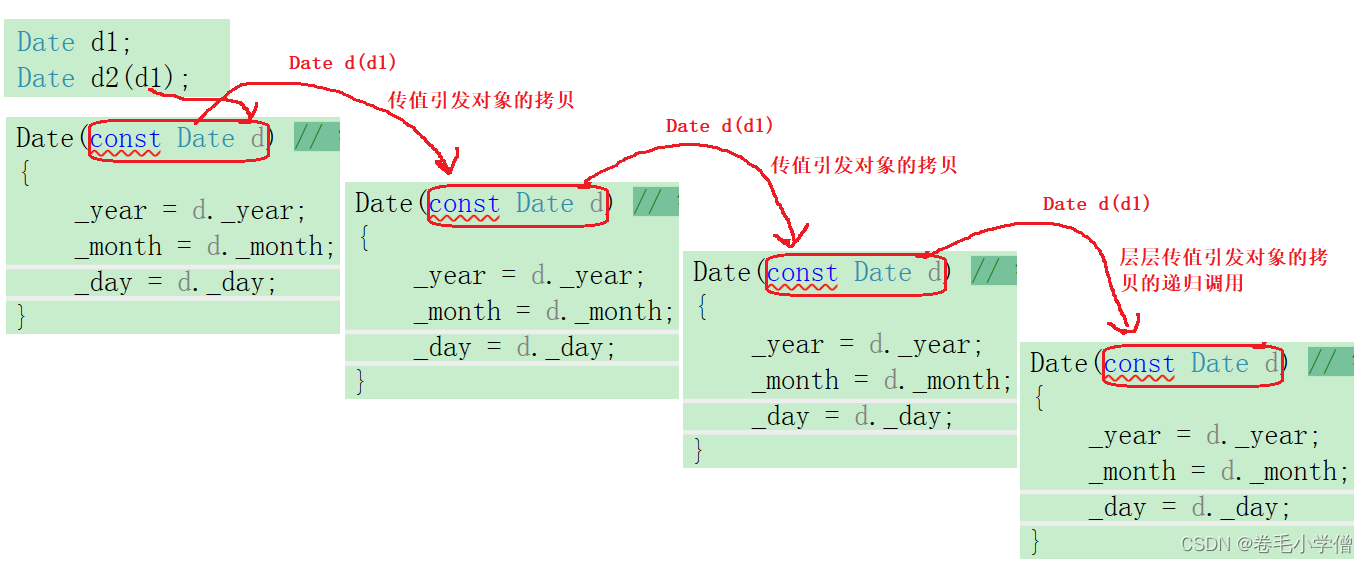
产生这个问题的原因:传值传参是将实参的一份临时拷贝作为参数传给函数,因此如果拷贝函数使用传值传参,那么在形成临时拷贝这一过程就会调用拷贝构造函数,就会导致拷贝的递归调用。
- 若未显式定义,编译器会生成默认的拷贝构造函数。 默认的拷贝构造函数对象按内存存储按字节序完成拷贝,这种拷贝叫做浅拷贝,或者值拷贝。
举个例子:
class Time
{
public:Time(){_hour = 1;_minute = 1;_second = 1;}Time(const Time& t){_hour = t._hour;_minute = t._minute;_second = t._second;cout << "Time::Time(const Time&)" << endl;}
private:int _hour;int _minute;int _second;
};
class Date
{
private:// 基本类型(内置类型)int _year = 1970;int _month = 1;int _day = 1;// 自定义类型Time _t;
};
int main()
{Date d1;// 用已经存在的d1拷贝构造d2,此处会调用Date类的拷贝构造函数// 但Date类并没有显式定义拷贝构造函数,则编译器会给Date类生成一个默认的拷贝构造函数Date d2(d1);return 0;
}

注意:在编译器生成的默认拷贝构造函数中,内置类型是按照字节方式直接拷贝的,而自定义类型是调用其拷贝构造函数完成拷贝的。
- 编译器生成的默认拷贝构造函数已经可以完成字节序的值拷贝了,还需要自己显式实现吗?当然像日期类这样的类是没必要的。那么下面这种类呢?
typedef int DataType;
class Stack
{
public:Stack(size_t capacity = 10){_array = (DataType*)malloc(capacity * sizeof(DataType));if (nullptr == _array){perror("malloc申请空间失败");return;}_size = 0;_capacity = capacity;}void Push(const DataType& data){// CheckCapacity();_array[_size] = data;_size++;}~Stack(){if (_array){free(_array);_array = nullptr;_capacity = 0;_size = 0;}}
private:DataType *_array;size_t _size;size_t _capacity;
};
int main()
{Stack s1;s1.Push(1);s1.Push(2);s1.Push(3);s1.Push(4);Stack s2(s1);return 0;
}
运行这段代码,我们会发现程序崩溃了。
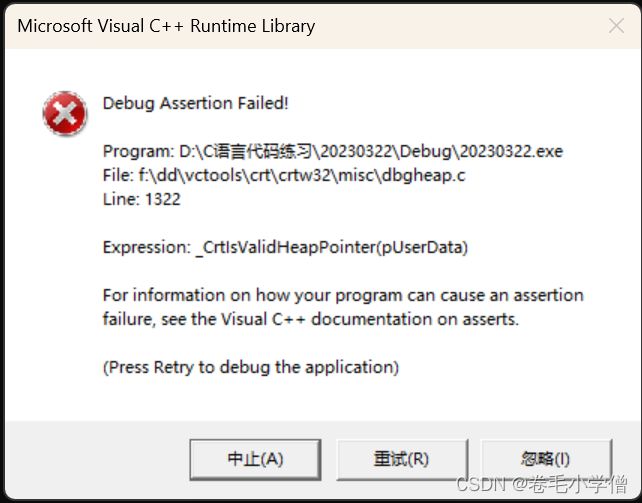
那么程序崩溃的原因是什么呢?
首先,通过调试我们发现程序崩溃是在结束程序的一瞬间,也就结束程序时出现了问题。
其次,通过上面的学习,我们知道程序结束,又或者对象在被销毁时会自动调用其析构函数,因此初步判断是析构函数出现问题。那么析构函数又为什么会出错呢?
接着,通过进一步调试分析,我们将问题锁定在拷贝构造这一部分:
如图所示,将拷贝构造这个操作注释编译器就可以成功编译。
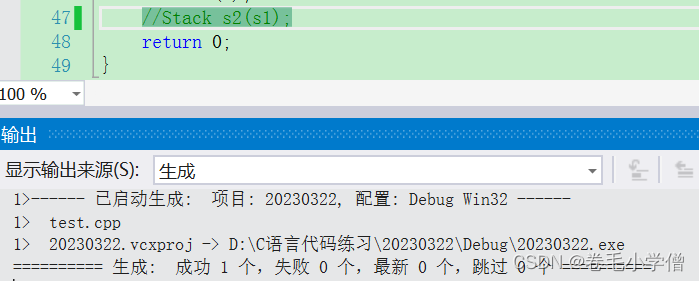
程序分析图解:
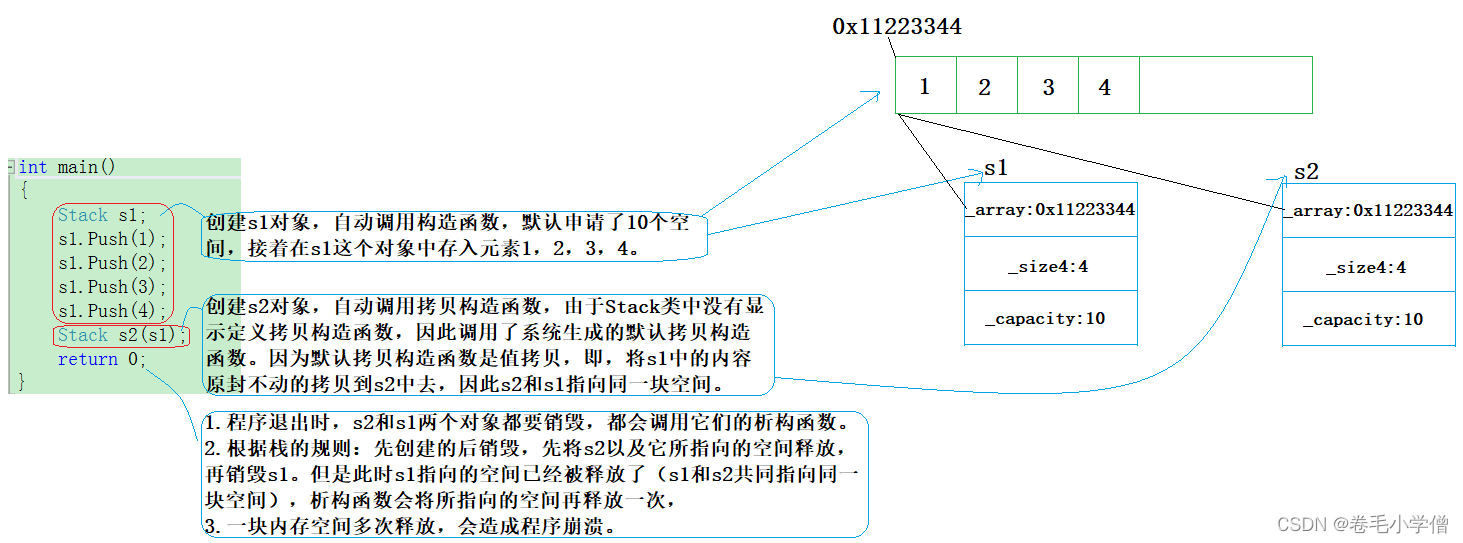
结论:类中如果没有涉及资源申请时,拷贝构造函数写不写都可以;一旦涉及到资源申请时,则拷贝构造函数是一定要写的,否则就是浅拷贝。
- 拷贝构造函数典型调用场景:
①使用已存在对象创建新对象
②函数参数类型为类类型对象
③函数返回值类型为类类型对象
举例:
class Date
{
public:Date(int year, int minute, int day){cout << "Date(int,int,int):" << this << endl;}Date(const Date& d){cout << "Date(const Date& d):" << this << endl;}~Date(){cout << "~Date():" << this << endl;}
private:int _year;int _month;int _day;
};
Date Test(Date d)
{Date temp(d);return temp;
}
int main()
{Date d1(2022, 1, 13);Test(d1);return 0;
}
运行结果:

程序分析图解:

注意:为了提高程序效率,一般对象传参时,尽量使用引用类型,返回时根据实际场景,能用引用尽量使用引用。
五、赋值运算符重载
1.运算符重载
C++为了增强代码的可读性引入了运算符重载,运算符重载是具有特殊函数名的函数,也具有其返回值类型,函数名字以及参数列表,其返回值类型与参数列表与普通的函数类似。
函数名为:关键字operator后面接需要重载的运算符符号。
函数原型:返回值类型 operator操作符(参数列表)
注意:
- 不能通过连接其他符号来创建新的操作符:比如operator@
- 重载操作符必须有一个类类型参数
- 用于内置类型的运算符,其含义不能改变,例如:内置的整型+,不能改变其含义
- 作为类成员函数重载时,其形参看起来比操作数数目少1,因为成员函数的第一个参数为隐藏的this
.*::sizeof?:.注意以上5个运算符不能重载。
// 全局的operator==
class Date
{
public:Date(int year = 1900, int month = 1, int day = 1){_year = year;_month = month;_day = day;}
private://只有当成员变量为公有时才能编译通过int _year;int _month;int _day;
};
// 这里会发现运算符重载成全局的就需要成员变量是公有的,那么问题来了,封装性如何保证?
bool operator==(const Date& d1, const Date& d2)
{return d1._year == d2._year&& d1._month == d2._month&& d1._day == d2._day;
}
void Test()
{Date d1(2018, 9, 26);Date d2(2018, 9, 27);cout << (d1 == d2) << endl;
}
int main()
{Test();return 0;
}
运行结果如下:
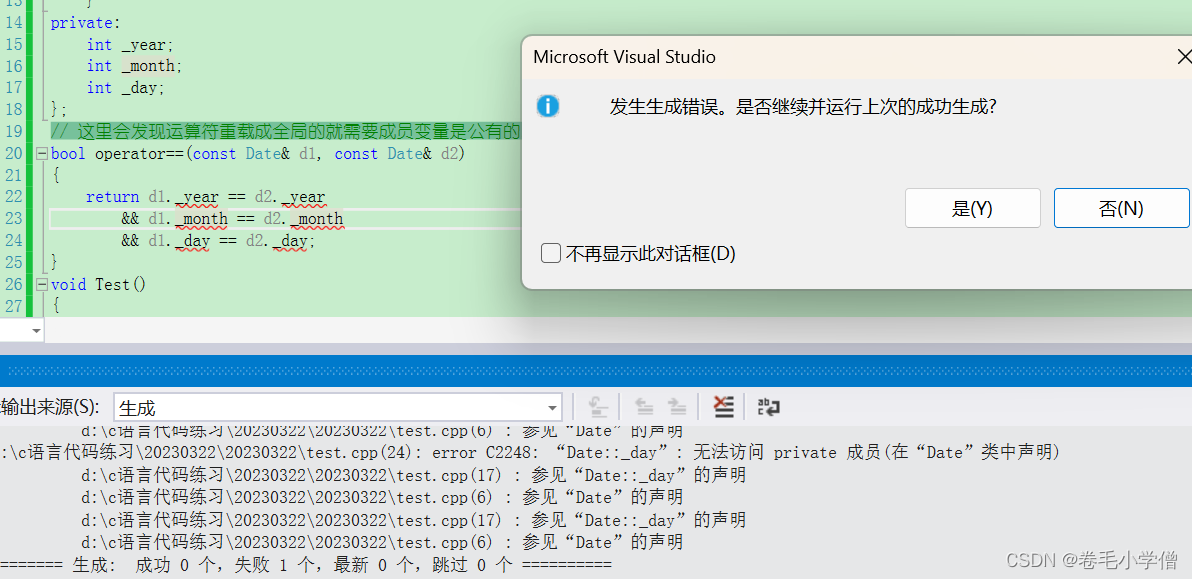
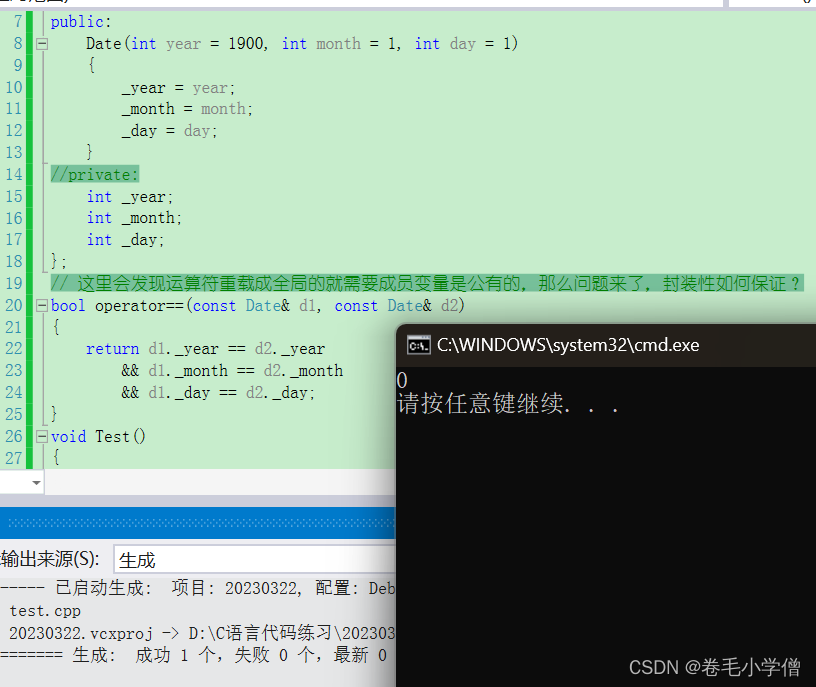
要保证这里的封装性我们有两种解决办法:
1.将全局函数声明为类的友元函数(关于友元函数之后会详细说明);
2.直接将函数定义为成员函数。
class Date
{
public:Date(int year = 1900, int month = 1, int day = 1){_year = year;_month = month;_day = day;}// bool operator==(Date* this, const Date& d2)// 这里需要注意的是,左操作数是this,指向调用函数的对象bool operator==(const Date& d2){return _year == d2._year&& _month == d2._month&& _day == d2._day;}
private:int _year;int _month;int _day;
};
void Test()
{Date d1(2018, 9, 26);Date d2(2018, 9, 27);cout << (d1 == d2) << endl;
}
int main()
{Test();return 0;
}
运行结果如下:
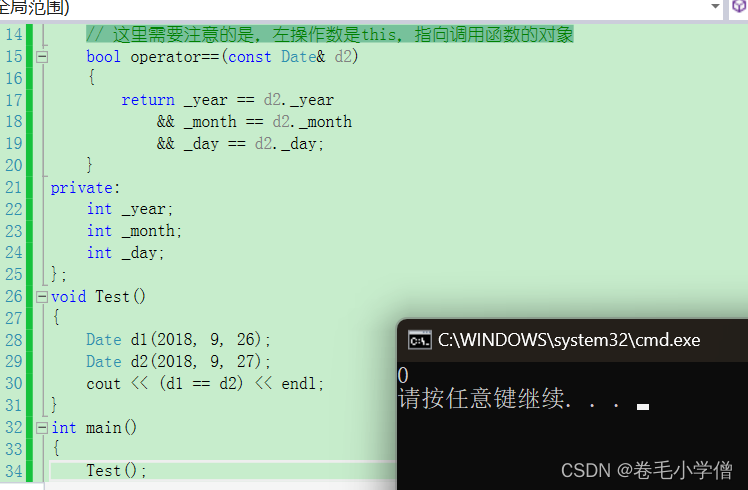
2.赋值运算符重载
1.赋值运算符重载格式
- 参数类型:
const T&,传递引用可以提高传参效率 - 返回值类型:
T&,返回引用可以提高返回的效率,有返回值目的是为了支持连续赋值 - 需要检测是否自己给自己赋值
- 返回
*this:要符合连续赋值的含义(如a=b=c=1,“=”运算符是从右至左结合,意味着先将1赋给c,再将c赋给b,再将b赋给a,此时 a,b,c都是1,即完成了连续赋值。)
class Date
{
public:Date(int year = 1900, int month = 1, int day = 1){_year = year;_month = month;_day = day;}Date(const Date& d){_year = d._year;_month = d._month;_day = d._day;}Date& operator=(const Date& d){if (this != &d){_year = d._year;_month = d._month;_day = d._day;}return *this;}
private:int _year;int _month;int _day;
};
2.赋值运算符只能重载成类的成员函数不能重载成全局函数
class Date
{
public:Date(int year = 1900, int month = 1, int day = 1){_year = year;_month = month;_day = day;}int _year;int _month;int _day;
};
// 赋值运算符重载成全局函数,注意重载成全局函数时没有this指针了,需要给两个参数
Date& operator=(Date& left, const Date& right)
{if (&left != &right){left._year = right._year;left._month = right._month;left._day = right._day;}return left;
}
运行结果:
编译失败:error C2801: “operator =”必须是非静态成员

出错原因:赋值运算符如果不显式实现,编译器会生成一个默认的。此时用户再在类外自己实现一个全局的赋值运算符重载,就和编译器在类中生成的默认赋值运算符重载冲突了,故赋值运算符重载只能是类的成员函数。

3.用户没有显式实现时,编译器会生成一个默认赋值运算符重载,以值的方式逐字节拷贝。
注意:内置类型成员变量是直接赋值的,而自定义类型成员变量需要调用对应类的赋值运算符重载完成赋值。
class Time
{
public:Time(){_hour = 1;_minute = 1;_second = 1;}Time& operator=(const Time& t){if (this != &t){_hour = t._hour;_minute = t._minute;_second = t._second;}return *this;}
private:int _hour;int _minute;int _second;
};
class Date
{
private:// 基本类型(内置类型)int _year = 1970;int _month = 1;int _day = 1;// 自定义类型Time _t;
};
int main()
{Date d1;Date d2;d1 = d2;return 0;
}
既然编译器生成的默认赋值运算符重载函数已经可以完成字节序的值拷贝了,还需要自己实现吗?当然像日期类这样的类是没必要的。那么下面这种类呢?
typedef int DataType;
class Stack
{
public:Stack(size_t capacity = 10){_array = (DataType*)malloc(capacity * sizeof(DataType));if (nullptr == _array){perror("malloc申请空间失败");return;}_size = 0;_capacity = capacity;}void Push(const DataType& data){// CheckCapacity();_array[_size] = data;_size++;}~Stack(){if (_array){free(_array);_array = nullptr;_capacity = 0;_size = 0;}}
private:DataType *_array;size_t _size;size_t _capacity;
};
int main()
{Stack s1;s1.Push(1);s1.Push(2);s1.Push(3);s1.Push(4);Stack s2;s2 = s1;return 0;
}
运行结果:
这种因为值拷贝造成的程序崩溃和拷贝构造函数中讲到的程序崩溃原因相同。

程序分析图解如下:
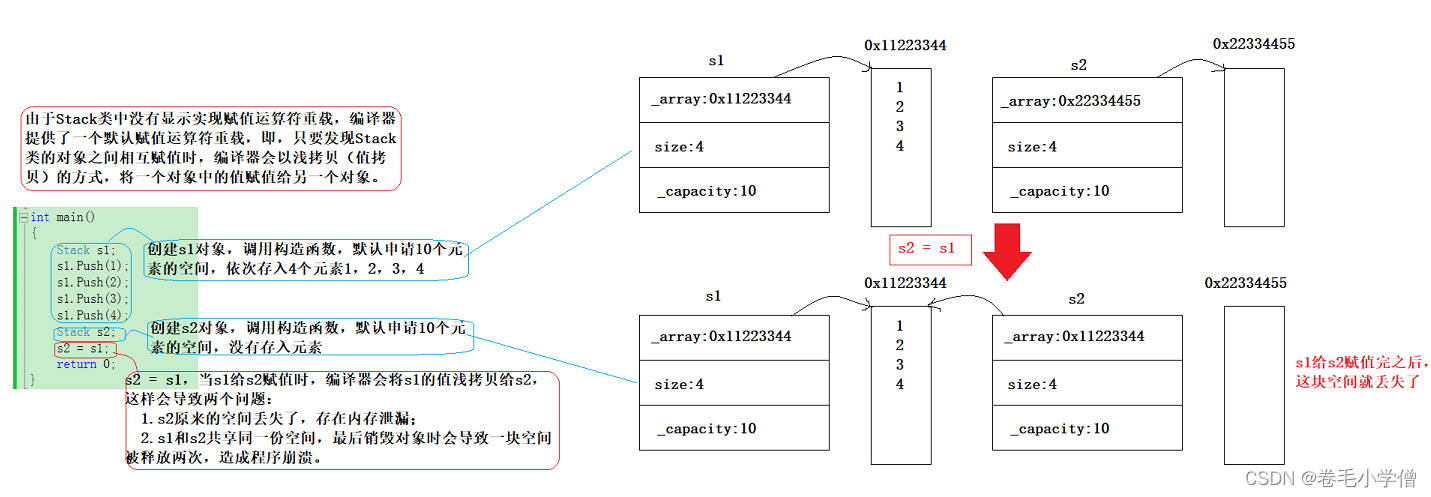
注意:如果类中未涉及到资源管理,赋值运算符是否实现都可以;一旦涉及到资源管理则必须要实现。
4. 前置++和后置++重载
class Date
{
public:Date(int year = 1900, int month = 1, int day = 1){_year = year;_month = month;_day = day;}// 前置++:返回+1之后的结果// 注意:this指向的对象函数结束后不会销毁,故以引用方式返回提高效率Date& operator++(){_day += 1;return *this;}// 后置++:// 前置++和后置++都是一元运算符,为了让前置++与后置++形成能正确重载// C++规定:后置++重载时多增加一个int类型的参数,但调用函数时该参数不用传递,编译器自动传递// 注意:后置++是先使用后+1,因此需要返回+1之前的旧值,故需在实现时需要先将this保存一份,然后给this + 1// 而temp是临时对象,因此只能以值的方式返回,不能返回引用Date operator++(int){Date temp(*this);_day += 1;return temp;}
private:int _year;int _month;int _day;
};
int main()
{Date d;Date d1(2022, 1, 13);d = d1++; // d: 2022,1,13 d1:2022,1,14d = ++d1; // d: 2022,1,15 d1:2022,1,15return 0;
}
六、取地址重载
1.日期类的实现
class Date
{
public:void Print(){cout << _year << "-" << _month << "-" << _day << endl;}// 获取某年某月的天数int GetMonthDay(int year, int month){static int days[13] = { 0, 31, 28, 31, 30, 31, 30, 31, 31, 30, 31, 30, 31 };int day = days[month];if (month == 2 && ((year % 400 == 0) || (year % 4 == 0 && year % 100 != 0)))//如果是闰年,则二月是29天{++day;}return day;}// 全缺省的构造函数Date(int year = 1900, int month = 1, int day = 1){_year = year;_month = month;_day = day;//检查日期是否合法if (_month > 12 || _day > GetMonthDay(_year, _month)){cout << "非法日期" << endl;}}// 拷贝构造函数// d2(d1)Date(const Date& d){_year = d._year;_month = d._month;_day = d._day;}// 赋值运算符重载// d2 = d3 -> d2.operator=(&d2, d3)Date& operator=(const Date& d){_year = d._year;_month = d._month;_day = d._day;return *this;}// 析构函数~Date(){_year = 0;_month = 0;_day = 0;}// 日期+=天数Date& operator+=(int day){do{int redays = GetMonthDay(_year, _month) - _day;if (redays > day){_day += day;day = 0;}else{day -= redays;_month++;if (_month == 13){_month = 1;_year++;}_day = 0;}} while (0 != day);return *this;}// 日期+天数Date operator+(int day){Date temp(_year, _month, _day);do{int redays = GetMonthDay(temp._year, temp._month) - _day;if (redays > day){temp._day += day;day = 0;}else{day -= redays;temp._month++;if (_month == 13){_month = 1;_year++;}temp._day = 0;}} while (0 != day);return temp;}// 日期-天数Date operator-(int day){Date temp(_year, _month, _day);do{if (temp._day >= day){temp._day -= day;day = 0;}else{day = day - temp._day;temp._month--;if (temp._month == 0){temp._year--;temp._month = 12;}temp._day = GetMonthDay(temp._year, temp._month);}} while (0 != day);return temp;}// 日期-=天数Date& operator-=(int day){do{if (_day >= day){_day -= day;day = 0;}else{day = day - _day;_month--;if (_month == 0){_year--;_month = 12;}_day = GetMonthDay(_year,_month);}} while (0 != day);return *this;}// 前置++Date& operator++(){*this += 1;return *this;}// 后置++ Date operator++(int) {Date temp(_year, _month, _day);*this += 1;return temp;}// 后置--Date operator--(int){Date temp(_year,_month,_day);*this -= 1;return temp;}// 前置--Date& operator--(){*this -= 1;return *this;}// >运算符重载bool operator>(const Date& d) const{if (_year > d._year){return true;}else if (_month > d._month){return true;}else if (_day > d._day){return true;}return false;}// ==运算符重载bool operator==(const Date& d) const{return (_year == d._year) && (_month == d._month) && (_day == d._day);}// >=运算符重载bool operator >= (const Date& d) const{return *this > d || *this== d;}// <运算符重载bool operator < (const Date& d) const{if (_year < d._year){return true;}else if (_month < d._month){return true;}else if (_day < d._day){return true;}return false;}// <=运算符重载bool operator <= (const Date& d) const{return *this < d || *this == d;}// !=运算符重载bool operator != (const Date& d) const{return !(*this == d);}// 日期-日期 返回天数int operator-(const Date& d) const{Date max = *this;Date min = d;int flag = 1;int day = 0;if (*this < d){max = d;min = *this;flag = -1;}while (max != min){min++;day++;}return day * flag;}
private:int _year;int _month;int _day;
};
2.const成员
将const修饰的“成员函数”称之为const成员函数。
const修饰类成员函数,实际修饰该成员函数隐含的this指针,即,在该成员函数中不能对类的任何成员进行修改。

我们来看看下面的代码:
class Date
{
public:Date(int year, int month, int day){_year = year;_month = month;_day = day;}void Print(){cout << "Print()" << endl;cout << "year:" << _year << endl;cout << "month:" << _month << endl;cout << "day:" << _day << endl << endl;}void Print() const{cout << "Print()const" << endl;cout << "year:" << _year << endl;cout << "month:" << _month << endl;cout << "day:" << _day << endl << endl;}
private:int _year; // 年int _month; // 月int _day; // 日
};
void Test()
{Date d1(2022, 1, 13);d1.Print();const Date d2(2022, 1, 13);d2.Print();
}
3.取地址及const取地址操作符重载
这两个默认成员函数一般不用重新定义,编译器默生成的就够用。
class Date
{
public:Date* operator&(){return this;}const Date* operator&()const{return this;}
private:int _year; // 年int _month; // 月int _day; // 日
};
这两个运算符一般不需要重载,使用编译器生成的默认取地址的重载即可,只有特殊情况,才需要重载,比如想让别人获取到指定的内容!
七、练习题
学习过本文后,或许我们可以尝试解答以下几个问题:
OJ题:两个栈实现一个队列
思考题:
1.const对象可以调用非const成员函数吗?
答:不能,这属于权限放大,是不允许的。非const成员函数中可能会存在修改const对象的可能。
2.非const对象可以调用const成员函数吗?
答:可以,这属于权限缩小,是允许的。
3.const成员函数内可以调用其它的非const成员函数吗?
答:不能,这属于权限放大,是不允许的。非const成员函数中可能会存在修改const对象的可能。
4.非const成员函数内可以调用其它的const成员函数吗?
答:可以,这属于权限缩小,是允许的。
总结
以上就是今天要讲的内容,本文介绍了C++面向对象中的六个默认成员函数的相关概念。本文作者目前也是正在学习C++相关的知识,如果文章中的内容有错误或者不严谨的部分,欢迎大家在评论区指出,也欢迎大家在评论区提问、交流。
最后,如果本篇文章对你有所启发的话,希望可以多多支持作者,谢谢大家!